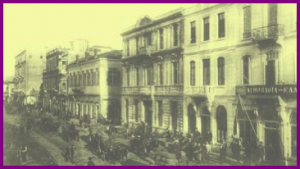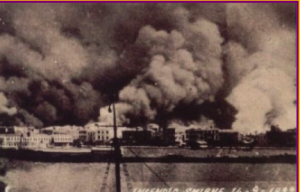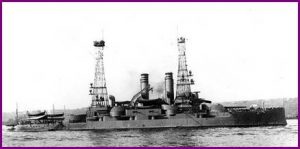by Roger Jennings1
In this remarkable example of “citizen diplomacy,” one determined individual saved countless lives. While the Turks, Greeks and Armenians all hotly contest the facts of the “burning of Smyrna” and the turmoil of the period even today, one issue is not in dispute—the courage and resourcefulness of the author’s grandfather. —The Editor
How the Greeks, Armenians and Jews were saved at Smyrna, and how Turkey was put on a course of peace and prosperity is revealed for the first time from private archives.
According to the Armenian proverb, “within the heart of every man sleeps a lion.” All citizens hope and expect that their leaders will deal effectively with the issues of the day, but at times that does not occur. Then the citizen must act. The obstacles can be overwhelming. A special person is required to be successful.
One such person unknown today saved 350,000 people from certain death in 11 days and 1,250,000 in nearly a year.2 This person then created the social relief and vocational training programs to raise the standard of living of a nation. When he died, his son carried on his work including arming the nation to preclude an invasion by Germany during World War II. The son then convinced the Government to risk its neutral status and a German invasion by allowing ships with flags of neutral countries, but loaded with food and arms from the United States, to pass through its territorial waters enroute to Russia. Providing aid to Russia helped to keep the Nazi army divided and fighting on two fronts.
The unknown person was Asa K. Jennings, an employee of the YMCA. He was sent to Smyrna, Turkey (known today as Izmir), in August 1922 with his family. Only 5’3” in height with a double curvature of his spine and still suffering the effects of tuberculosis, Asa was left in charge of the YMCA while others went on vacation. Two weeks later the Turkish Army defeated the Greek Army. The Greek Army retreated in panic to the port city of Smyrna along with thousands of civilians.

In 1919 Greece had landed an Army of some 60,000 troops at Smyrna. The Army drove inland with the intent to annex part of the Ottoman Empire as new territories of Greece. This was to be a reward for joining the Allies during World War I. Other countries also occupied parts of Turkey pursuant to the Treaty of Sevres. The Nationalist Government of Turkey and its leader Mustafa Kemal, later known as Ataturk, rejected the Treaty. The Nationalists formed an army and attacked the Greeks.
Civilians for two hundred miles around feared the advancing Turks. Five trains a day each with 55 cars packed with people brought refugees to Smyrna. There was a steady stream of humanity walking and riding in carts, all heading for the safety of Smyrna. Food and water were scarce. The Greek Army proceeded to Cesme outside of Smyrna to board ships. No police or soldiers were in the city to protect the civilians from robbery, rape and killing.
 |
 |
| Asa K. Jennings |
Asa Jennings formed the American Relief Committee. Most of its members were from the International College in the Paradise section (now known as Sirinyer) of Smyrna. They arranged for flour to be sent from the warehouse of Near East Relief in Istanbul on U.S. Navy ships to feed the masses. Ovens and fuel had to be found. Wealthy Greeks who could pay for passage out of the City donated their houses to the Committee. One house became a maternity ward. Others became orphanages for 2000 children. Young, vulnerable women were crowded into other houses to avoid the most unspeakable of crimes. Representatives of Near East Relief, American Women’s Hospital, Red Cross and other organizations joined the relief effort. The U.S. Navy had several destroyers in the Eastern Mediterranean with crews of about 100-125 men per ship to provide humanitarian aid. The sailors patrolled the city, but were greatly outnumbered by the undisciplined brigands who entered the City intent on plunder before the Turkish Army arrived. The U.S. Navy panned its searchlights at night over the masses of people huddled on the wharf as a way of preventing some of the crimes being committed against people. The people were praying for ships to come to their rescue, but no ships came.
The senior U.S. diplomat present was George Horton. He was repeatedly invited to the meetings of the American Relief Committee. Asa asked George Horton at each meeting to take action on behalf of the refugees. There were now more than 350,000 people in the port, 300,000 of whom were Greeks. George Horton was married to a Greek woman. More than anyone, Horton had the title and prestige to seek an agreement with the Turks that would protect the civilians. The U.S. had enjoyed friendly relations with the Turks during World War I despite technically being at war. U.S. missionaries continued to work for the benefit of the Turks all during the War. Horton’s response to Asa’s requests was merely to bring the subject up at the next meeting. Despite repeated requests, Horton, in fact, did nothing on behalf of the refugees.

On September 13, 1922, the city was on fire and all U. S. and U. K. citizens were ordered by the U.S. and British navies to leave the city on warships. Horton boarded a U. S. Navy destroyer and left more than 300,000 Greeks and 50,000 Armenians and Jews to be marched to the interior of Turkey and certain death like the Armenians in Eastern Turkey years earlier. All of the U.S. and U.K. citizens left Smyrna save one. Asa K. Jennings decided to stay behind to do what he could do in these very desperate circumstances. Now that there was no senior diplomat present, Asa did not have to defer to anyone and could take what he considered to be the best course of action.
The Turkish Army camp was located within view of the Jennings’ house at the International College. The Jennings children had watched the Greek and Turkish soldiers days before engaged in hand-to-hand combat. Asa was overcome with great emotion and desire to save these helpless people crowded, body pressed against body, on the wharf. He drove his YMCA Chevy to the Turkish Army camp and got a meeting with the Turkish supreme leader, Mustafa Kemal. 3

Asa K. Jennings and Mustafa Kemal were an interesting contrast. Kemal was a legend and hero among the Turks. He had defeated the British at Gallipoli and organized the Nationalists into a party representing the will of the Turkish people. His word was law, and he could order the execution of anyone. By contrast, Asa K. Jennings was a 5’3” hunchback with no title, staff or resources at his command. Asa did have great faith and determination. He had an engaging personality, armed always with a smile that allowed him to make friends with everyone he met. He was mentally quick and creative, but most of all he was pragmatic and persistent.
Asa wanted the refugees to be allowed to leave Turkey. Kemal did not want to kill these people, but he could not leave them in the City where there was no food, water or sanitation. Kemal’s first objective was the expulsion of foreign armies, but his second and more difficult objective was to stop the civil violence. Turkey had been plagued for years with violence. There was no civil authority to prevent violence. Bruce Clark, an Editor at The Economist, states on p. 13 of his book Twice a Stranger, “It has been estimated that about 20 per cent of the population of Anatolia died violently during the last ten years of the Ottoman empire’s existence: some 2.5 million Muslims, up to 800,000 Armenians and 300,000 Greeks.” Asa’s request to remove the minorities from Turkey was accepted by Mustafa Kemal as the way to bring peace and prosperity to both the Turks and the non-Muslim refugees.
Kemal imposed conditions. Jennings had only 7 days to remove the 350,000 refugees from Smyrna. These people could not remain in the City indefinitely due to the food, water, sanitation and security problems. No Greek flags could be displayed, such as on the ships, because that would enrage the Turkish soldiers who had witnessed so much death and destruction at the hands of the Greeks. No rescue ships could tie up at the wharf, because the Turks wanted to control the evacuation. No men of military age (17-45) could leave Smyrna, because the Turks did not want them returning as a new invading army. The men would go to labor camps. Asa was in no position to bargain. He accepted the best agreement he could get, and left in his Chevy for the port of Smyrna.
Asa requested and received a boat with coxswain from the U.S. Navy. First, he went to the French merchant ship Pierre Loti. The ship had plenty of room to take refugees to the safety of a nearby Greek island. The French captain did not want to get involved, and sailed off with an empty ship while thousands were begging to be rescued. Farther out in the harbor was an Italian ship, the Constantinople. The Italian ship captain agreed to take 2000 people, but first he had to receive a bribe. Asa, being a pragmatic person, raised and paid the bribe price, and loaded the 2000 people. Then the Italian captain demanded an increase in the bribe price. When challenged by Jennings, the Italian said the Greeks might not let the refugees disembark. Asa responded that he would go along on the trip to the port of Mytilene and take responsibility for disembarkation.
When the ship arrived Asa K. Jennings was surprised to see Greek soldiers everywhere, and ships at anchor. There were no problems getting the refugees off the ship, and Asa went to the Greek Army headquarters. Repeatedly Jennings asked Greek General Frankou for the ships to remove the refugees from Smyrna. The Turks had guaranteed safe passage, and the U.S. Navy had pledged protection for the Greek merchant ships. Frankou repeatedly refused to make the ships available. Asa was very frustrated with Frankou, a Greek, who was unwilling to save 300,000 of his countrymen. However, Jennings did not know at the time that Frankou was part of a group of Greek officers planning a coup of the Greek Government. The officers needed the ships and soldiers to gain power, and that was more important to them than the lives of so many people.
As Asa, infuriated, came out of an early morning meeting with Frankou he saw a battleship entering the harbor. Jennings boarded the Greek battleship Kilkis. Captain Theofanides was very willing to help even though an officer of superior rank had turned Asa down. Asa then proceeded to write a series of messages to the Greek Prime Minister, which Captain Theofanides translated into Greek. The messages were then taken to the radio room where the messages were encoded for security. At first, the response was the Prime Minister was sleeping. Asa demanded the Prime Minister be awakened. Then the Prime Minister wanted a Cabinet meeting. Messengers had to be sent around Athens to awaken ministers to attend the meeting. Asa had a seven-day time limit while confronted by government officials who did not share Asa’s sense of urgency. Finally, the Prime Minister and his Cabinet responded saying no ships could go to Smyrna. They feared the Turks would capture the ships and invade the Greek islands.

Asa then sent his ultimatum. If the ships were not made available to rescue the Greeks and others in Smyrna, Asa’s next message would not be in code. The message would be sent openly so the world would know the Greek Government allowed the Turks to kill 300,000 Greek citizens. The blackmail worked. All of the ships in the area were put under Asa’s control, but he would be personally responsible, if any ship was lost. The merchant ship captains were notified that the Greek Government had seized their ships, and they were to prepare to steam to Smyrna. The captains were afraid to enter a Turkish port. Some said their ships had mechanical problems and would not be able to make the trip. Captain Theofanides ordered the merchant captains to a meeting on the Kilkis. He informed the merchant captains that they would face court-martial, if their ships were not ready to leave by midnight. All the ships sailed at midnight with Asa on the first ship.
Families were separated, with the women, young and old people boarding the ships under the protection of the U.S. Navy. The Turks relaxed their conditions and allowed ships to tie up at the railroad pier to expedite loading. The Turks also extended the deadline from seven to eleven days. The men had gone to labor camps and everyone else had evacuated the port. During the operation the coup occurred in Athens, and the new Government endorsed the successful work Asa was doing. For days Jennings had been receiving urgent requests for ships to remove refugees from other ports. Once Smyrna was completed the Turkish officials authorized Asa to take ships to all ports from the Black Sea to Syria. The new Greek Government expanded Asa’s fleet to 55 ships. All the refugees recognized him immediately with his hunchback and called him “Admiral.” Wherever he went in Greece, people would kneel before him like the Host was being brought down the street. People would want to kiss his hands and feet. Many wanted help finding lost relatives. By December 500,000 people had been removed. The Patriarch of the Eastern Orthodox Church stated that 1,250,000 people were removed to safety before the rescue operation was completed.
This addition to the population of Greece put a great strain on Greece. People were living in tent cities on many Greek islands. Adequate food and other forms of support were a constant problem. Disease broke out in the unsanitary environments. Greece, however, had received the educated and skilled people who had sustained the Ottomans for so many years. Turkey was left with soldiers and very few people with education and working skills. The increase in population was such a great problem in Greece that the Greek Government asked the Nationalist Government to accept ethnic Turks who had lived in Greece for generations and who had no connections with Turkey. The Greeks wanted to reduce their population. The Turks accepted these ethnic Turks after the refugees had been removed from Turkey. There never was a population exchange occurring at one time, as often reported, but rather two events occurring at different times.
Once Turkey had established its sovereignty by driving the foreign armies out of Turkey the terms of World War I were re-negotiated as the Treaty of Lausanne. Greece and Turkey did not recognize each other. Turkey held many Greeks as prisoners of war. The Greeks held a few Turks. The Turks offered one Greek in exchange for each Turk received. Greeks and Turks hated each other after all the atrocities of war. A Greek diplomat would not be successful negotiating with the Turks. The Greek Government knew that Asa K. Jennings commanded the respect, friendship, and confidence of Mustafa Kemal and the Turkish Government. So the Greek Government appointed Asa K. Jennings, an American citizen, to be the diplomat representing Greece for the repatriation of POWs at the Treaty of Lausanne. The Turks knew the Greeks would not negotiate with a Turkish diplomat, and that Asa was a national hero in Greece. So Turkey appointed Asa as its diplomat for the repatriation of POWs at the Treaty of Lausanne. Perhaps unique in history, one person was representing two countries at war to negotiate a settlement of a critical issue.
Asa requested and received the help of the U.S. Navy to transport all POWs in such a way that the Turks could not keep count. The U.S. Navy from the earliest days of the crisis was under the command of Rear Admiral Mark L. Bristol who, along with the captains and crews of the U.S. Navy ships, assisted Asa K. Jennings in every way possible often risking their own lives.
For his service to Greece, Asa K. Jennings was awarded the highest military decoration of Greece, The Medal of Military Merit, and the highest civilian decoration, The Golden Cross of St. Xavier. The Patriarch presented the Golden Cross. This was the first time in Greek history that one person received the highest military and civilian decorations simultaneously. Perhaps the most touching recognition is a scroll presented by a group calling itself The Common Committee of the Non-liberated Hellenes. The scroll reads “The Common Committee …recognizing with gratitude your majestic and valuable services in saving 300 thousand refugees exposed to the danger of being slaughtered by the blood-thirsty Kemal, and the many dangers and labor to which you were submitted during their transportation and safe-conduct in Greek territory, Herald You, the real altruist, for this humanitarian action…”
Asa was asked by both Greece and Turkey to stay on for humanitarian work. He could not be in both countries at the same time. Greece was a modern country with an educated population and friends in the world. Turkey had been ravaged by war, had an uneducated population, and socially was very under developed. In 1923 the Turkish Republic was founded with its first President, Mustafa Kemal. He asked Asa to establish social organizations around Turkey modeled after the YMCA while President Kemal was closing mosques and suppressing the mullahs. President Kemal wanted to secularize and modernize Turkey. The term Christian was offensive to Muslims. Asa formed The American Friends of Turkey with an advisory council of Turks to provide vocational training, establish orphanages, and build playgrounds to teach competition without killing, and more. Asa had established a strong relationship with Turkey’s first President. That relationship has existed ever since, and today the U.S. and Turkey are strong allies.
After Asa K. Jennings died in 1933 his son Asa W. Jennings met with President Kemal. Asa W. had been aide to his Father from the earliest days of Smyrna and had attended the meetings his Father had over the years with President Kemal. Asa W. informed the President that the activities of The American Friends of Turkey would be discontinued due to insufficient funds during the Great Depression. Asa W. had just graduated from NYU Law School and was immediately appointed as Turkey’s lawyer for its activities in the U.S. The effectiveness of the Jennings men on behalf of Turkey led in 1940 to a request that Asa W. Jennings obtain multiple shiploads of arms so Turkey could defend itself from an anticipated invasion by Germany. U.S. law and the attitude of the American people prevented any involvement in the European war. Despite that obstacle, Asa W. was able to get the military aid a year before the Lend-Lease Act was passed to authorize transfers of military materials. Turkey went on full mobilization, and Germany never attacked. After Pearl Harbor Asa W. used the prior aid to Turkey to persuade the Turkish Government to risk its neutral status and invite a German invasion by allowing ships with neutral flags to pass through the Bosporus enroute to Russia with food and arms. By providing aid to Russia the U.S. was forcing the Nazi army to fight on two fronts rather than being able to concentrate their forces.![]()
End Notes
1 This article was based upon extensive records left by Asa K Jennings and Asa W. Jennings. Both men kept diaries and copies of reports, letters; and diaries of refugees, photos, and more. The archives include thousands of pages, most of which have never been published. Comments and questions can be directed to the author at rjenningsmfgco@yahoo.com.
2 Most of the exhibits included in Ships of Mercy by Christos Papoutsy came from only one 3-ring binder loaned to Mr. Papoutsy. A second book The Saga of a Friendship: Asa Kent Jennings and The American Friends of Turkey, written in English by Rifat Bali, but sold only in Turkey was based in part on 2500 photocopies made from the Jennings’ archives. The Bali book, which is available from the author also used other sources, such as the papers of Admiral Mark L. Bristol, USN, at the National Archives and the records of the YMCA.
3 The meeting between Asa K. Jennings and Mustafa Kemal is depicted in a 1945 MGM short movie titled Strange Destiny. The film was produced based on information provided by Asa W. Jennings and Amy W. Jennings, the widow of Asa K. Jennings. Asa K. Jennings received gifts from President Kemal including his personal worry beads and a signed photo addressed to Asa K. Jennings by the President. The frame that came with the photo has President Kemal’s monogram GMK. His signature was Ghazi M. Kemal. The title Ghazi was of more importance than President to the man later named Ataturk by the Turkish legislature.

Roger L. Jennings is the grandson of Asa K. Jennings and the son of Asa W. Jennings. He was raised in a family focused on the economic development of countries like Afghanistan, Iran, Iraq, and Turkey. His father was an international lawyer and Roger Jennings traveled extensively with his father including to Iraq after the coup that replaced the royal family and Turkey after the coup that replaced Prime Minister Menderes. Today Roger Jennings has extensive records inherited from his grandfather and father relating to events from 1922 to 1972 in Turkey. These records were the principal sources for Ships of Mercy: The True Story of the Rescue of the Greeks Smyrna, September 1922 by Christos Papoutsy and The Saga of a Friendship: Asa Kent Jennings and The American Friends of Turkey by Rifat Bali.
